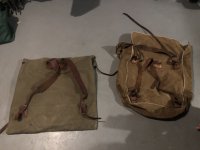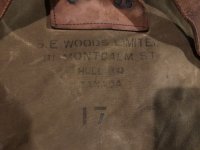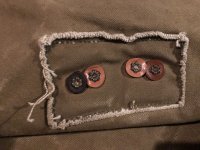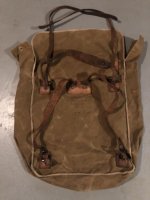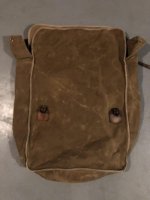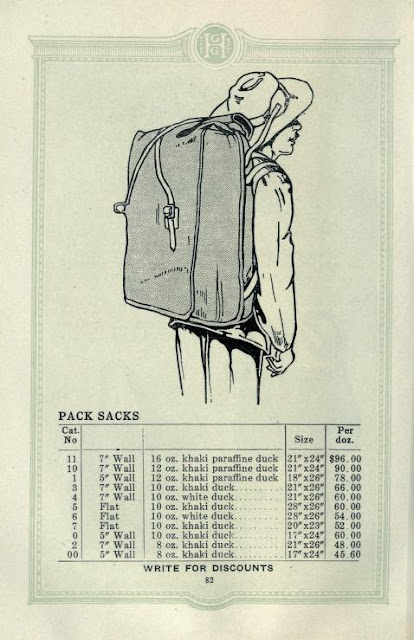Thanks for posting about your S.E. Woods Pack. Not too many out there in circulation. I've been researching the "Woods" pack design and its association with canoe tripping in Canada for an upcoming article in the WCHA Journal,
Wooden Canoe.
You asked about the history of the company and the original intent of the pack. Here's some info you might find useful.
James W. Woods (1863-1930) started his prolific business empire originally supplying canvas packs and other goods to outfit lumbermen from his base in Ottawa, so I guess you could say his products were originally meant for the forestry industry. Woods Ltd. operated from 1895-1912 when through a series of mergers and buyouts, he expanded the business to include tents, sleeping bags (then called 'sleeping robes'), clothing and supplies marketed to surveyors, explorers, trappers, outdoorsmen, etc . Becoming more than just a retailer, Woods was also successful in acquiring textile companies like Empire Canvas and was therefore able to manufacture the canvas needed for his various products while also controlling the supply chain for raw canvas needed by his many competitors. He also made a fortune by having a Canadian Government contract for his canvas military tents during WW1 by which time he owned seven factories in several Canadian cities and a cotton mill. Anything made after 1918 utilized their new corporate name, "Woods Manufacturing Co"
A
dated page on the myccr website mentions this Pack design was first made back in 1909, but I haven't been able to source any existing Woods Ltd. catalogues to confirm this. However, I do know that another competing Canadian manufacturer, Grant-Holden-Graham Ltd., was advertising this style pack as far back as 1917. G-H-G was the direct competitor to Woods in Ottawa with its factory literally across the river in the city of Hull, Quebec. Here's a photo of the pack from 1917 and the
link to the catalogue free to view on Archive.org.
As you can see the listings mention plenty of size and material options including "16oz. khaki paraffine duck" which would basically be an early form of waxed canvas of today.
In 1947, workers at the various Woods factories went on strike to form a union effectively shutting down production for over a year. To compensate for the labour dispute, the two sons of James W. formed their own new company, S.E. Woods, in order to continue making the gear with non-union workers while capitalizing on the name recognition the "Woods Brand" still carried. In the early '50s, S.E. Woods bought out the remnants of competitor Grant-Holden-Graham and took over their larger manufacturing factory across the river in Hull. This is why your pack's inked label says Hull, PQ (Province du Quebec).
The Toronto Reference Library has a single surviving copy of a 1953 S.E. Woods catalogue in their special collection archive. I checked it out as part of the research. By now S.E. Woods was marketing to hunters, trappers and other outdoorsmen. Don't have a photo, but in these early years, the packs were being advertised with a number sequence of #12 to # 17. Pack # 17 is cited as being 23" x 27" x 9" with a leather tumpline and made from 18oz waterproof (i.e. waxed) olive green duck. This was the heaviest duty canvas weight in their line. The catalogue mentioned a weight capacity of 175 pounds! It would have been a beast of a pack!
By the early 60's the company trimmed down all their products lines, including limiting the size variations of this pack design. They probably realized few could really carry a fully loaded #17 pack very far. The packs were reduced in sized but still made with heavy weight canvas. It's therefore likely your #17 dates from the that time.
After the 1964 closure of S.E Woods, the parent Woods company survived but shifted production to other items with newer materials like nylon. They continued to make a single, non-waxed canvas version of these packs (the No.1) with generally decreasing canvas / leather quality as the years went on. A significant number of these packs were continually ordered after 1972 by the Ontario Government's Ministry of Natural Resources. Well into the late 80s/early 90s, the were used by fire fighters to haul loads of fire hoses, fuel jugs, chainsaws in the bush. etc.. Far as I can tell, this is when the #200 pack with its integrated leather axe head sheath was created. Fire crews wanted a convenient spot on the exterior of the pack to store their axes and quickly be able to deploy the tool when needed.
There are a few sold online as collector items, many modified with hi-visibility cloth or other repairs:
https://www.etsy.com/au/listing/700626319/heavy-canvas-pack-mnr-fire-hose-pack
https://www.etsy.com/ca/listing/704458844/old-omnr-hose-pack-heavy-canvas-pack?show_sold_out_detail=1&ref=nla_listing_detail s
So in a roundabout way, James Woods' pack once again was being used by the forestry industry which started his whole business enterprise.
Being such a large volume, rugged pack, you can see why they became popular with the canoe tripping crowd. Many of them were inexpensively sourced by kids canoe camps from those discarded by the fire crews. It didn't hurt that they were featured in Bill Mason's paddling films so that fuelled their popularity too.
As it happens my father was a Forest Fire Superintendent in the Cochrane District of Northern Ontario in the early 80s. To keep me out of trouble, he would often bring me to the various camps to work (as free labour) helping to maintain the hoses and prep the packs. They would get quite musty if weren't cared for and seemed they were constantly soaked in fuel and oil. At the time I hated them, but now restored a few and happily use them when tripping.
The old Woods No.2 Manufacturing plant is located a short distance from my home here in Toronto. Most of the factory building still stands and has now been repurposed. There's a neat little heritage walking tour the city has developed with an online guide. Here's the link to the specific page about the factory if interested:
https://exploredundascarlaw.heritagetoronto.org/HT-MIT-stop08.html
